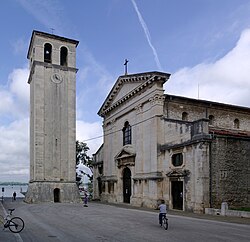Pula Cathedral
| Pula Cathedral | |
|---|---|
| Cathedral of the Assumption of the Blessed Virgin Mary, Pula | |
 |
|
| 44°52′18″N 13°50′40″E / 44.87167°N 13.84444°ECoordinates: 44°52′18″N 13°50′40″E / 44.87167°N 13.84444°E | |
| Location | Pula |
| Country | Croatia |
| Denomination | Roman Catholic |
| History | |
| Past bishop(s) | Juraj Dobrila |
| Architecture | |
| Functional status | Co-cathedral |
| Administration | |
| Diocese | Poreč-Pula |
| Clergy | |
| Bishop(s) | Ivan Milovan |
The Pula Cathedral or fully the Cathedral of the Assumption of the Blessed Virgin Mary (Croatian: Katedrala uznesenja Blažene Djevice Marije) is a co-cathedral in Pula, Croatia. Along with the Euphrasian Basilica it is one of the two official seats of the Roman Catholic Diocese of Poreč and Pula. The church is located on the south side of the Pula bay at the foot of the hill with the 17th century Venetian fort. The site of the present-day church has been used for religious worship since ancient Roman times and the first Christian churches on the site were built in the late 4th and early 5th century AD. These had gone through a series of enlargements and reconstructions over the ages.
It is believed that the site of the present-day church hosted a temple dedicated to Jupiter Conservator in Roman times. Archeological excavations also revealed ruins of Roman thermae on that location, and it is considered likely that during the Diocletianic Persecution local Christians used it for secret gatherings.
In the 4th and 5th centuries a whole complex of ancient Christian buildings was gradually erected on the location. A small church whose width corresponds to the present-day cathedral's central nave was built first, which was followed in the mid 4th century by a single-nave church of St. Thomas next to it. These two were incorporated into an extended hall church in the early 5th century. In the second half of the 5th century it was further transformed into a three-nave basilica which featured architectural elements popular in the northern Adriatic of the time, such as the apse set in the facade and the entirely flat rear side of the church. At around the same time, a baptistery which had a cross-shaped floor plan and a bishop's residence were built in front of the basilica, but they were both later demolished in the 19th century after the diocese seat was moved to Poreč in 1828.
...
Wikipedia

